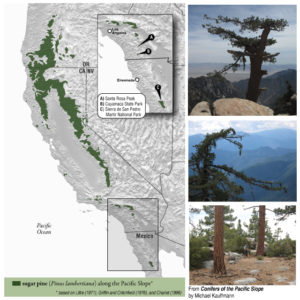Sugar pine
Pinus lambertiana
Tree: to 260′ and 11′ DBH; crown conical, becoming flat-topped; long branches, often horizontal
Bark: reddish-brown and narrowly furrowed, flaking in small platelets that collect at the base in mounds; becoming paler with elevation and exposure
Needles: 3’’- 4’’, growing in clusters of 5, blue-green; white stomatal bloom on all sides, including 2 distinct lines on the underside
Seed Cones: 10”- 20”, thicker scales than the western white pine and average 6” longer, yellow-green maturing to yellow-brown; quite sappy; present on tree year-round
Habitat: 1,500′- 9,000′, montane forests, ridgetops, and steep hillsides, generally drier habitat with ample sunlight
Observations: tremendous specimens in mid-elevations of Yosemite National Park; also found in Klamath Mountains, Transverse Ranges, southern Cascades, Sierra de San Pedro Martir
Remarks: world’s largest pine
Information from Conifers of the Pacific Slope by Michael Kauffmann.


